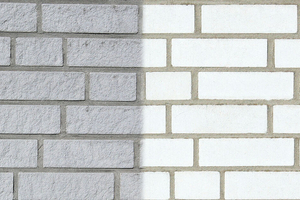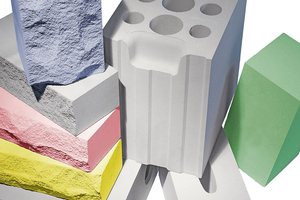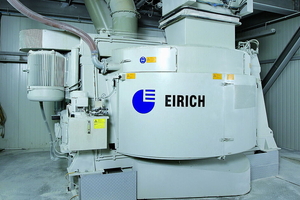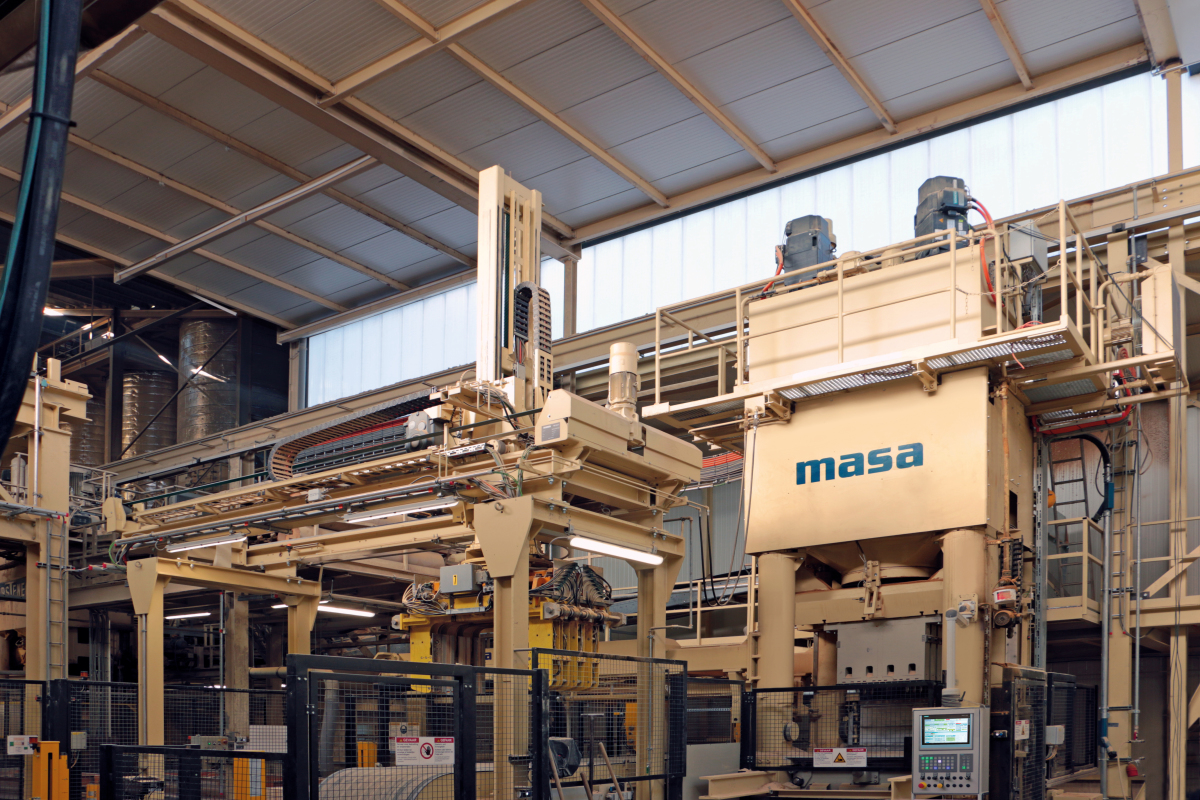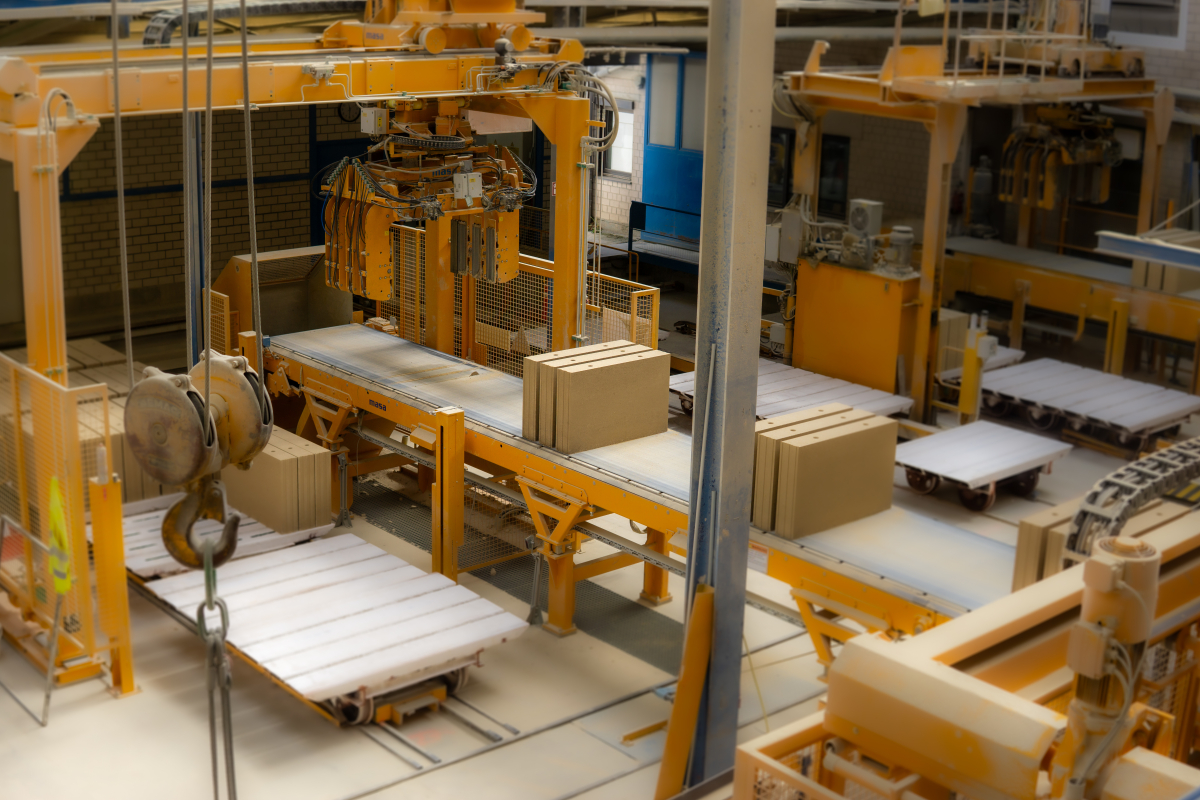Decarbonization through efficiency – how modern mixing technology reduces the carbon footprint of sand-lime brick production
It is well known that the building materials industry is one of the largest emitters of greenhouse gases worldwide. While cement manufacturers can primarily reduce their process-related emissions, sand-lime brick producers can already achieve savings in raw material processing. Advanced mixing technology, such as that developed by Maschinenfabrik Gustav Eirich GmbH & Co KG, makes this possible.
Sand-lime brick has a more favorable carbon footprint than some other building materials: With specific emissions of between 50 and 120 kg CO₂/t of end product, it is significantly lower than the values for concrete or bricks. In addition, sand-lime brick has the property of recarbonation: over the course of its life cycle, the building material binds back up to 40-50 kg CO₂/t, i.e., around 40-50% of the emissions released during production. Nevertheless, sand-lime brick production also generates greenhouse gas emissions, which, according to recent studies in Germany, are approximately 80% (approx. 640 000 t CO₂/a) attributable to quicklime production and approximately 20% (approx. 160 000 t CO₂/a) attributable to the process energy used [1].
The figures suggest that even small savings in quicklime consumption or process energy can have a significant positive impact on the climate. With the right mixing technology, both the amount of quicklime and the amount of binding agent can be reduced. The reason for this is that the quality of the lime-sand mixture has a significant influence on the reaction effectiveness in the autoclave. Eirich intensive mixers use a mixing principle in which the container and mixing tools move independently of each other. This enables a more homogeneous distribution of the components compared to conventional mixing systems.
Laboratory tests prove that this improved homogenization leads to higher bulk densities (by about 10%) and early compressive strengths (up to 50%) [2]. Eirich’s mixing technology makes it possible to reduce the binder content without compromising strength, which leads directly to verifiable CO₂ savings.
Emission reduction through modern mixing technology
The uniform distribution of lime in the Eirich mixer means that the proportion of quicklime can also be reduced while maintaining the same reaction efficiency. Studies show that reducing the quicklime content from 7 to 6% by mass – when replenished with inert limestone powder – can save around 0.01-0.02 t of CO₂ per ton of sand-lime brick [3]. This corresponds to around 15-25% less CO₂ from the binder component. A medium-sized plant with an annual production of 100 000 t would thus emit around 1000–2100 t less CO₂ per year. This reduction in lime also requires the mixture to be extremely uniform and for every grain of sand to be coated with reactive lime. Only modern intensive mixers can meet this requirement.
Another approach to reducing the use of quicklime is to use metallurgical slag as a substitute. These by-products of steel production contain 16 to 48% quicklime by mass. A research project conducted by the Forschungsgemeinschaft Eisenhüttenschlacken (FehS, Research Association for Ironworks Slag) and Deutsche Bundesstiftung Umwelt (DBU, German Federal Environmental Foundation) showed that ironworks slag can be successfully used as a substitute for sand and lime. The challenge lay in the uniform distribution of the heterogeneous components – here, the Eirich intensive mixer proved to be crucial for the reliable processing of such formulations. The climate benefit is twofold: on the one hand, less CO₂-intensive fresh lime needs to be burned, and on the other hand, industrial waste is upgraded to a valuable raw material.
A promising opportunity to further improve the climate balance of the building material is the return of recycled sand-lime brick to the production cycle. Currently, however, only around 10% of the primary raw materials can be replaced by recycled material [4]. This is due to the existing strict regulations, which only allow pure material that is completely free of impurities to be used for sand-lime brick production. However, since it is not yet possible to completely avoid minor impurities (e.g., from mortar) in sand-lime brick waste material, the practicality of the current regulations has been under debate for several years. If a small amount of contaminated material were permitted for production, the importance of sand-lime brick as a recyclable material could increase once again [5].
Energy savings through pre-slaking
In addition to material savings, the second major lever for CO₂ reduction is the reduction of energy consumption in production – especially in the steam curing process. One option is to pre-slake the quicklime in the mixer using steam. This involves carrying out the highly exothermic reaction CaO + H₂O Ca(OH)₂ outside the autoclave. This results in energy savings because...
...the material reaches the autoclave already preheated (70-80 °C)
...hardening can take place in a shorter time and at lower pressure, as hydration is already complete
...steam consumption per batch is reduced
Initial studies indicate energy savings of around 10% in the hardening process [6]. Since process energy consumption accounts for around 20% of total emissions, implementing this measure could enable further significant CO₂ savings.
Intensive mixers make the production “greener”
In addition to direct emission reductions through quicklime and process energy savings, modern mixing machines also contribute indirectly to greater sustainability through quality and efficiency improvements:
Less waste: Every defective brick avoided saves raw materials and recycling energy
More precise process control: Uniform mixtures enable more accurate dosing and reduce safety margins
Waste can also be avoided, for example, by breaking down clay (components) in the sand used: The intensive mixer better separates such components, minimizing clumping in the mixture.
In addition, intensive mixers transfer more mechanical energy in less time, thus achieving a homogeneous result more quickly – often in a matter of minutes, whereas older systems take longer and are less efficient. The robust design also ensures high availability and lower wear [7]; breakdowns or maintenance stops, which cost energy and time, are minimized.
Conclusion
Modern mixing technology from Eirich demonstrates how optimized processes can significantly reduce CO₂ emissions in sand-lime brick production. While many other decarbonization approaches are still being researched, these efficiency gains are already available today. This opens up realistic opportunities for the sand-lime brick industry to optimize its carbon footprint in line with current requirements. In times of rising energy costs and stricter environmental regulations, modern mixing technology is thus becoming a strategic sustainability tool: ecological improvements go hand in hand with economic advantages. Decarbonization in the building materials industry begins with the right mix.
energieeffizientere-kalksandsteinindustrie/
Hauptbericht.pdf
https://www.bba-online.de/news/kalksandstein-geschlossene-stoffkreislaeufe/
https://www.dgfm.de/presse/artikel/fuer-eine-klimaneutrale-zukunft-
nachhaltig-mineralisch-bauen
https://www.eirich.de/de/produkteverfahren/mischtechnik/mischsystem

